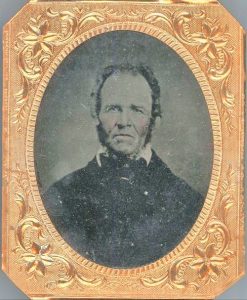Jireh Platt Diary
Excerpted by Rev. H.D. Platt in “Some Facts About the Underground Railroad in Ill.” Typescript March 20, 1896, Wilbur H. Siebert Underground Railroad Collection, Ohio Memory https://ohiomemory.org/digital/collection/siebert/id/8659
The following excerpt comes from the diary of an abolitionist living in Mendon, Illinois during the 1840s and 1850s. Jireh Platt (1798-1870) was a farmer and Congregationalist deacon, born in Connecticut, and who spent many years in western Illinois helping enslaved families escape from Missouri. Rev. Henry Dutton Platt (1823-1903) inherited many of his father’s papers, including a diary that described Underground Railroad operations around Mendon. Rev. Platt shared excerpts from this diary along with some of his own recollection in a typescript he sent to pioneering UGRR scholar Wilbur H. Siebert in 1896. Siebert then included a few of the passages in his groundbreaking work, The Underground Railroad From Slavery To Freedom (1898) on p. 9. The full scope of the diary excerpts provided by Platt’s son in 1896 are reprinted below and include a passage we can now identify (“December 5 year not given”) as being related to the 1853 Palmyra Stampede. The passages in italics come from Henry D. Platt (the son). Those in regular font come from the original Jireh Platt diary.
I make now a few quotations from a sort of diary and farm record of my father’s, which came into my hands at his death. There was a “blue book,” which had vastly more in it, and some very exciting records.
May 19, 1848. Hannah Coger arrived on the U.G. Railroad, the last $100.00 for freedom she was to pay to Thomas Anderson Palmyra, Missouri –the track is kept bright it being the 3rd time occupied since the 1st of April.
November 17, ’48. John Buckner arrived in a car –had been acquainted with Thornton and others that have traveled this way. Had been sold to a trade, and was to start South Next Monday morning. He had spent most of the time for a week in sawing off his chain with an old casa-knife. [Here follows a cut of the knife]
[no date, but between September 5 and September 14, 1849] It is rumored that John escaped, not long since from the [steamer] Kate Kearniey.
December 5 [year not given] within a month past, there has been a great stir, advertising, telegraphing, and hunting property from Missouri. Oh, what a spectacle! Eleven pieces of property, walking in Indian file, armed and equipped facing the North Star! $3000.00 offered for their apprehension, after they were safe in Canada! The hunters say they must have gone from Mendon to Jacksonville on a new track.
July 1, 1854 – Henry Edwards took passage on the U.G. Railroad, for fear of being sent South, report says. From St. Louis, and within a few weeks past, William crossed the Mississippi river in a dugout padding with a shingle-board after having been shot at. Also one other, who had been taken to Pike County Jail, and the sheriff commanded them to let him go. He had a bullet hole through his left arm.
November 9, ’54. Negro hoax stories have been very high in the market for a week past.
November 2, ’57. Freedom progressing. Within a few weeks 10 tickets have been disposed of at the U.R. Depot and among the passengers were Harrison, slave of the Free State Governor of Missouri, Caroline, Bonaparte and Stephen. I was informed last fall by neighbor Metcalf, that one of his old Kentucky friends had lost 5.
October 1859. U.G.R.R. Conductor reported the passage of 5 who were considered very valuable pieces of Ebony, all designated by names such as John Brooks, Daniel Brooks, Mason Bushrod, Silvester Lucket and Hanson Ganes. Have understood also that three others were ticketed about mid-summer.
This is the last record of the sort in the book. These are among the least thrilling of many which I know occurred.
These passages from Jireh Platt’s diary and from Rev. H.D. Platt’s 1896 recollection shared with Siebert also appear with additional context and photographs in Ruth Deters, The Underground Railroad Ran Through My House (2008), see especially pp. 205-7.
FURTHER READING
1917 || Speech by Ferry Luther Platt (grandson of Jireh, son of Luther Hart Platt) at family reunion, “The Platt-Cottrell Spirit,” Kirwin, KS Kansan, October 31, 1917 (Newspapers.com)
“…The old Mendon homestead was a station on the Underground Railroad and many are the incidents I have heard father [Luther Hart Platt] relate of experience with Missouri Slave Drivers. Once Grandfather had $1000 offered for his capture dead or alive, as a violator of the Fugitive Slave Law. A band of slave drivers had traced some refugees to his door and riding up before the house, they whetted their bowie knives on the rail fence demanding the surrender of the negroes, and swearing terrible vengeance if this demand was refused, but they did not try to enter, for it was common talk that Deacon Platt kept an ax hanging just inside each outside door to brain the man who attempted to force an entrance to this home, and no negro slave was thought valuable enough to risk the life of a white hunter.”
1917 || Neighbor Anna V. Baldwin writes to Ferry Luther Platt ca. 1916, excerpted in Kirwin, KS Kansan, November 07, 1917 (Newspapers.com)
“…I forgot to tell you that your Grandfather’s home was a station on the Underground Railroad. It had a place in the cellar where from 1 to 10 people could be hidden….”

